2016 MITSUBISHI OUTLANDER SPORT hood release
[x] Cancel search: hood releasePage 3 of 398
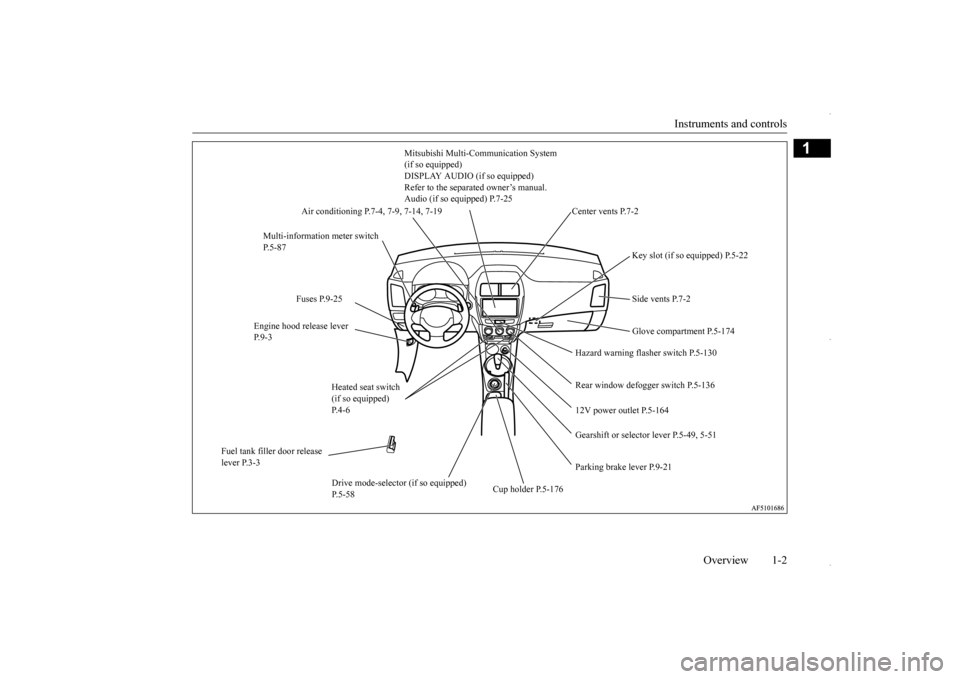
Instruments and controls
Overview 1-2
1
Mitsubishi Multi-Communication System (if so equipped) DISPLAY AUDIO (if so equipped) Refer to the separated owner’s manual.Audio (if so equipped) P.7-25
Multi-information meter switch P.5-87
Key slot (if so equipped) P.5-22 Side vents P.7-2
Fuses P.9-25
Engine hood release lever P.9-3
Glove compartment P.5-174
Hazard warning flasher switch P.5-130 Rear window defogger switch P.5-136
Air conditioning P.7-4, 7-9, 7-14, 7-19
12V power outlet P.5-164 Gearshift or selector
lever P.5-49, 5-51
Fuel tank filler door release lever P.3-3
Parking brake lever P.9-21
Drive mode-selector (if so equipped) P.5-58
Cup holder P.5-176
Center vents P.7-2
Heated seat switch (if so equipped) P. 4 - 6
BK0229600US.bo
ok 2 ページ 2015年10月1日 木曜日 午後2時29分
Page 96 of 398

Theft-alarm system 5-34 Features and controls
5
You and your family should familiarize your- selves with the location and operation of the liftgate release lever. 1. Open the lid (A) inside of the liftgate. 2. Move the lever (B) to open the liftgate.
3. Push out on the liftgate to open it.
N00510201283
The theft-alarm system is designed to provide protection from unauthorized entry into thevehicle. This system is operated in three stages: the first is the “armed” stage, the sec- ond is the “alarm” stage, and third is the “dis-armed” stage. If triggered, the system provides both audible and visual alarm sig- nals.
Park the vehicle and stop the engine. Arm the system as described below. 1. Except for vehicles equipped with the F.A.S.T.-key, remove the key from the ignition switch. For vehicles equipped with the F.A.S.T.-key, put the operation mode in OFF. 2. Make sure that the engine hood is closed. 3. Lock all doors and the liftgate by usingthe keyless entry system or the F.A.S.T.- key operation.
To open
WA R N I N G Always keep the release lever lid on the liftgate closed when driving so that your luggage cannot accidentally bump thelever and open the liftgate.
Theft-alarm system
CAUTION Do not modify or add parts to the theft-alarm system. Doing so could cause the theft-alarm to malfunction.
Armed stage Arm the system and leave
BK0229600US.bo
ok 34 ページ 2015年10月1日 木曜日 午後2時29分
Page 339 of 398
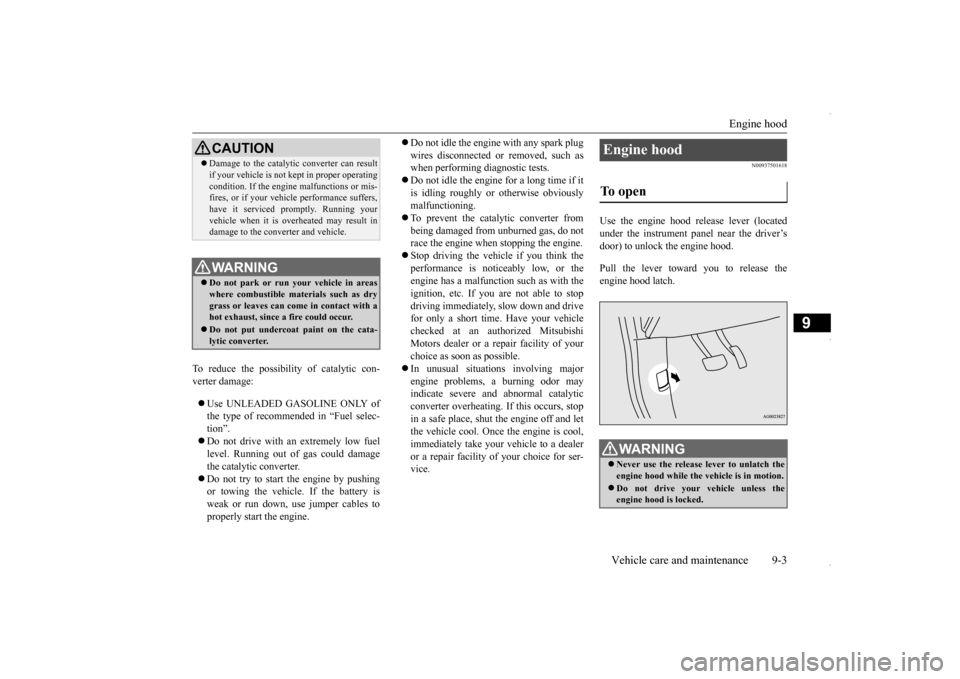
Engine hood
Vehicle care and maintenance 9-3
9
To reduce the possibility of catalytic con- verter damage: Use UNLEADED GASOLINE ONLY of the type of recommended in “Fuel selec- tion”. Do not drive with an extremely low fuel level. Running out of gas could damage the catalytic converter. Do not try to start the engine by pushing or towing the vehicle. If the battery is weak or run down, use jumper cables to properly start the engine.
Do not idle the engine with any spark plug wires disconnected or removed, such as when performing diagnostic tests. Do not idle the engine for a long time if it is idling roughly or otherwise obviously malfunctioning. To prevent the catalytic converter from being damaged from unburned gas, do not race the engine when stopping the engine. Stop driving the vehicle if you think the performance is noticeably low, or theengine has a malfunction such as with the ignition, etc. If you
are not able to stop
driving immediately, slow down and drivefor only a short time. Have your vehicle checked at an authorized Mitsubishi Motors dealer or a repair facility of yourchoice as soon as possible. In unusual situations involving major engine problems, a burning odor mayindicate severe and abnormal catalytic converter overheating. If this occurs, stop in a safe place, shut the engine off and letthe vehicle cool. Once the engine is cool, immediately take your vehicle to a dealer or a repair facility of your choice for ser-vice.
N00937501618
Use the engine hood release lever (locatedunder the instrument panel near the driver’sdoor) to unlock the engine hood. Pull the lever toward you to release the engine hood latch.
CAUTION Damage to the catalytic converter can result if your vehicle is not kept in proper operating condition. If the engine malfunctions or mis- fires, or if your vehicle performance suffers, have it serviced promptly. Running yourvehicle when it is overheated may result in damage to the converter and vehicle.WA R N I N G Do not park or run your vehicle in areas where combustible materials such as dry grass or leaves can come in contact with a hot exhaust, since a fire could occur. Do not put undercoat paint on the cata- lytic converter.
Engine hood To open
WA R N I N G Never use the release lever to unlatch the engine hood while the vehicle is in motion. Do not drive your vehicle unless the engine hood is locked.
BK0229600US.bo
ok 3 ページ 2015年10月1日 木曜日 午後2時29分
Page 340 of 398
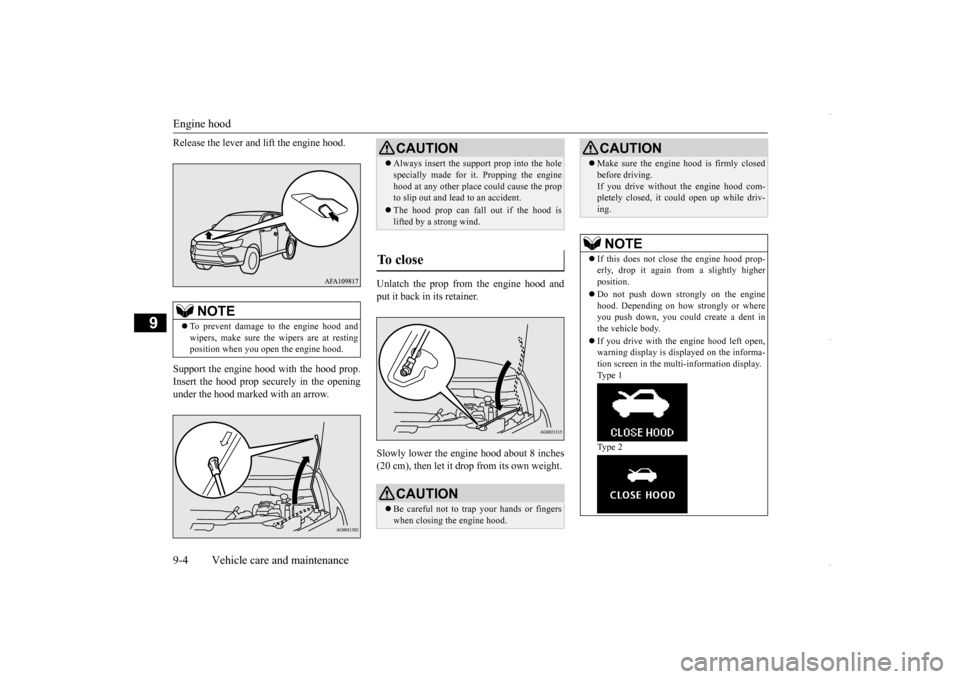
Engine hood 9-4 Vehicle care and maintenance
9
Release the lever and lift the engine hood. Support the engine hood with the hood prop. Insert the hood prop securely in the opening under the hood marked with an arrow.
Unlatch the prop from the engine hood and put it back in its retainer. Slowly lower the engine hood about 8 inches (20 cm), then let it drop from its own weight.
NOTE
To prevent damage to the engine hood and wipers, make sure the wipers are at resting position when you open the engine hood.
CAUTION Always insert the support prop into the hole specially made for it. Propping the engine hood at any other place could cause the prop to slip out and lead to an accident. The hood prop can fall out if the hood is lifted by a strong wind.
To close
CAUTION Be careful not to trap your hands or fingers when closing the engine hood.
Make sure the engine hood is firmly closed before driving. If you drive without the engine hood com- pletely closed, it could open up while driv- ing.NOTE
If this does not close the engine hood prop- erly, drop it again from a slightly higher position. Do not push down strongly on the engine hood. Depending on how strongly or where you push down, you could create a dent inthe vehicle body. If you drive with the engine hood left open, warning display is displayed on the informa- tion screen in the multi-information display. Type 1 Type 2CAUTION
BK0229600US.bo
ok 4 ページ 2015年10月1日 木曜日 午後2時29分
Page 360 of 398
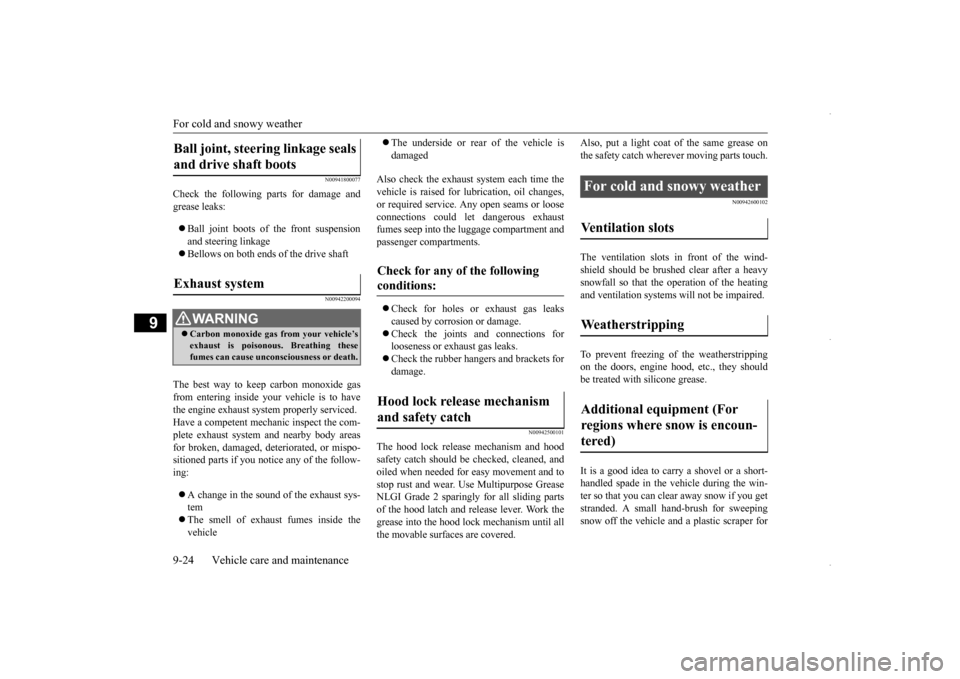
For cold and snowy weather 9-24 Vehicle care and maintenance
9
N00941800077
Check the following parts for damage and grease leaks: Ball joint boots of the front suspension and steering linkage Bellows on both ends of the drive shaft
N00942200094
The best way to keep carbon monoxide gas from entering inside your vehicle is to have the engine exhaust system properly serviced. Have a competent mechanic inspect the com-plete exhaust system and nearby body areas for broken, damaged, deteriorated, or mispo- sitioned parts if you notice any of the follow-ing: A change in the sound of the exhaust sys- tem The smell of exhaust fumes inside the vehicle
The underside or rear of the vehicle is damaged
Also check the exhaust system each time the vehicle is raised for lubrication, oil changes, or required service. Any open seams or looseconnections could let dangerous exhaust fumes seep into the luggage compartment and passenger compartments. Check for holes or exhaust gas leaks caused by corrosion or damage. Check the joints and connections for looseness or exhaust gas leaks. Check the rubber hangers and brackets for damage.
N00942500101
The hood lock release mechanism and hood safety catch should be checked, cleaned, and oiled when needed for easy movement and tostop rust and wear. Use Multipurpose Grease NLGI Grade 2 sparingly for all sliding parts of the hood latch and release lever. Work thegrease into the hood lock mechanism until all the movable surfaces are covered.
Also, put a light coat of the same grease on the safety catch wherever moving parts touch.
N00942600102
The ventilation slots in front of the wind-shield should be brushed clear after a heavysnowfall so that the operation of the heating and ventilation systems will not be impaired. To prevent freezing of the weatherstripping on the doors, engine hood, etc., they should be treated with silicone grease. It is a good idea to carry a shovel or a short- handled spade in the vehicle during the win- ter so that you can clear away snow if you getstranded. A small hand-brush for sweeping snow off the vehicle and a plastic scraper for
Ball joint, steering linkage seals and drive shaft boots Exhaust system
WA R N I N G Carbon monoxide gas from your vehicle’s exhaust is poisonous. Breathing these fumes can cause unconsciousness or death.
Check for any of the following conditions: Hood lock release mechanism and safety catch
For cold and snowy weather Ventilation slots Weatherstripping Additional equipment (For regions where snow is encoun- tered)
BK0229600US.bo
ok 24 ページ 2015年10月1日 木曜日 午後2時29分
Page 392 of 398

Capacity 11-6 Specifications
11
* : similar high quality ethylene glycol based non-silicate, non-am
ine, non-nitrate and non-borate
coolant with long life hybrid
organic acid tech-
nologyTransfer oil .53 qt (0.5 L)
Mitsubishi Motors Genuine Super Hypoid Gear Oil API classi- fication GL-5 SAE 80
Differential
Rear axle .42 qt (0.4 L)
Mitsubishi Motors Genuine Super Hypoid Gear Oil API classi- fication GL-5 SAE 80
Brake/Clutch (if so equipped) As required C
onforming to Brake fluid DOT3 or DOT4
Hood lock release mechanism and safety catch As required Multipurpose type grease NLGI Grade 2Engine coolant {Includes .69 qt (0.65 L) in reserve tank}
7.9 qt (7.5 L)
Mitsubishi Motors Genuine Super Long Life Coolant Premium or equivalent
*
Washer fluid 4.8 qt (4.5 L) —
Refer to the “Air con- ditioning label” on
page 11-2.
HFC-134a
Item
Capacity
Lubricants
BK0229600US.bo
ok 6 ページ 2015年10月1日 木曜日 午後2時29分
Page 395 of 398
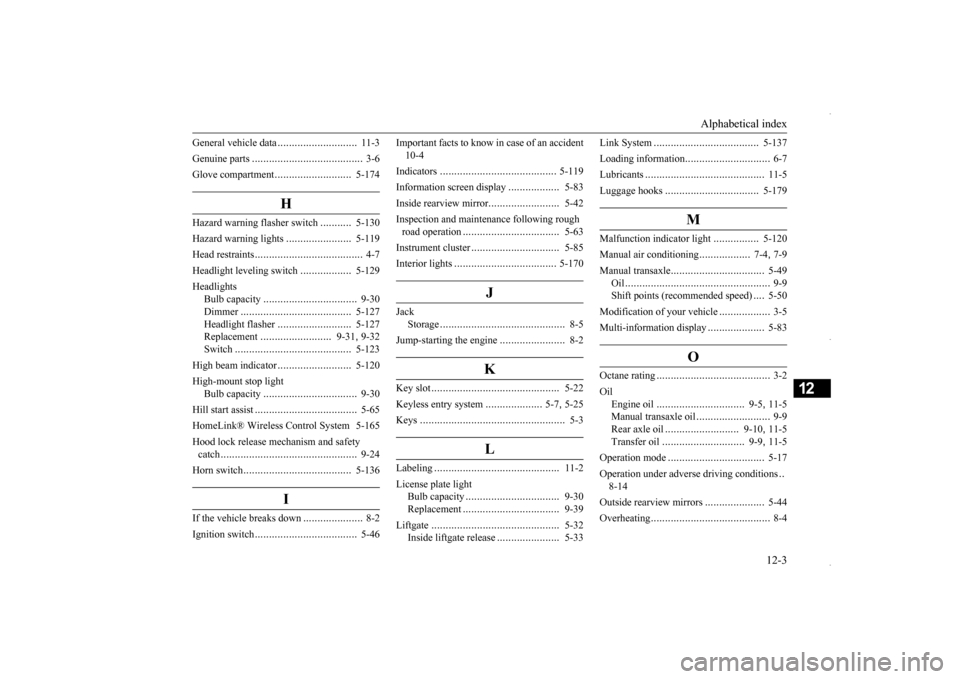
Alphabetical index
12-3
12
General vehicle data
............................
11-3
Genuine parts
....................
...................
3-6
Glove compartment
...........................
5-174
H
Hazard warning flasher switch
...........
5-130
Hazard warning lights
.......................
5-119
Head restraints
...................
...................
4-7
Headlight leveling switch
..................
5-129
Headlights
Bulb capacity
................
.................
9-30
Dimmer
....................
...................
5-127
Headlight flasher
..........................
5-127
Replacement
.........................
9-31
, 9-32
Switch
......................
...................
5-123
High beam indicator
..........................
5-120
High-mount stop light
Bulb capacity
................
.................
9-30
Hill start assist
...................
.................
5-65
HomeLink® Wireless Control System 5-165Hood lock release mechanism and safety catch
........................
........................
9-24
Horn switch
...................
...................
5-136
I
If the vehicle breaks down
.....................
8-2
Ignition switch
...................
.................
5-46
Important facts to know in case of an accident 10-4 Indicators
....................
.....................
5-119
Information screen display
..................
5-83
Inside rearview mirror
.........................
5-42
Inspection and maintenance following rough road operation
...................
...............
5-63
Instrument cluster
................
...............
5-85
Interior lights
...................
.................
5-170
J
Jack
Storage
........................
....................
8-5
Jump-starting the engine
.......................
8-2
K
Key slot
.......................
......................
5-22
Keyless entry system
....................
5-7
, 5-25
Keys
...........................
........................
5-3
L
Labeling
......................
......................
11-2
License plate light
Bulb capacity
..................
...............
9-30
Replacement
...................
...............
9-39
Liftgate
.......................
......................
5-32
Inside liftgate release
......................
5-33
Link System
..................
...................
5-137
Loading information
..............................
6-7
Lubricants
.....................
.....................
11-5
Luggage hooks
..................
...............
5-179
M
Malfunction indicator light
................
5-120
Manual air conditioning
..................
7-4
, 7-9
Manual transaxle
................
.................
5-49
Oil
............................
.......................
9-9
Shift points (recommended speed)
....
5-50
Modification of your vehicle
..................
3-5
Multi-information display
....................
5-83
O
Octane rating
.....................
...................
3-2
Oil
Engine oil
...............................
9-5
, 11-5
Manual transaxle oil
..........................
9-9
Rear axle oil
..........................
9-10
, 11-5
Transfer oil
.............................
9-9
, 11-5
Operation mode
.................
.................
5-17
Operation under adverse driving conditions
..
8-14 Outside rearview mirrors
.....................
5-44
Overheating
.......................
...................
8-4
BK0229600US.bo
ok 3 ページ 2015年10月1日 木曜日 午後2時29分